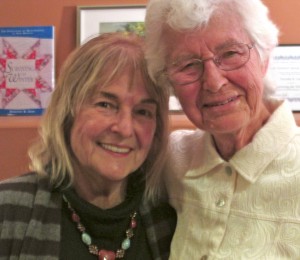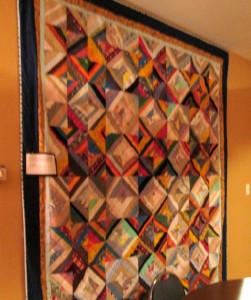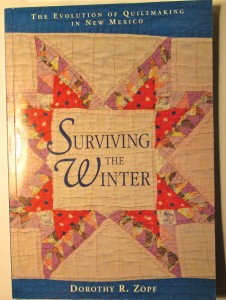“Quilts fulfill one of our most primal needs, that of shelter. There is a bond between maker and user, whether across months or generations.” – Dorothy Zopf, Surviving the Winter
On a recent bitterly cold and snowy evening here in Taos, residents of the Taos Retirement Village gathered in their warm and cozy book-lined social hall to listen to a lively lecture by one of their own. Expert quilter Dorothy Zopf, 86, who’d been a teacher for decades, knew just how to capture and maintain her large audience’s attention: through entertaining stories of her many adventures writing her book, Surviving the Winter: The Evolution of Quiltmaking in New Mexico (UNM Press, 2001).
As everyone who’s survived a winter here in the lower Rockies knows, New Mexico’s winters can be brutal; and bed quilts, especially those made with care and love, can make all the difference. Dorothy’s beautifully written, illustrated, and researched book, as she states in the first chapter, pieces together “the story of keeping warm in rural New Mexico.”
Every summer for six years, from 1991 to 1996, Dorothy and her team of volunteers traveled the state to interview quilters and glean their stories. In all, they recorded data on 352 quilt makers, aged from five to eighty-five, and 848 quilts, dating from 1900 to 1996. They visited eight counties, equally divided between northern and southern New Mexico, and they clocked over 3,000 miles.
At the recent Village gathering, one of the original members of Dorothy’s team, writer and photographer Lorraine Ciancio (who was one of Dorothy’s “scribes”), joined her on the dais. “This was the beginning of a wonderful adventure!” Dorothy enthused. The gathering was rapt. She began by sharing some of their behind-the-scenes stories.

“In the spirit of adventure, it was our team’s standing rule never to eat in the same place twice,” Dorothy-the-storyteller continued. “This led to making a U-turn in Estancia because there were so many cars parked under a Bar-B-Q sign. Not only was the food good, but at the next table there were three customers and ten legs. The four table legs were wearing blue yeans and cowboy boots!”
On another trip, at an old cantina in the former mining town of Magdalena, the team discovered the ceiling “festooned with signed dollar bills — an act that assured a prospector one last drink even if he had gone bust,” Dorothy said.
Dorothy then described some of the more unusual materials used for quilts in the frugal rural areas of New Mexico. She held up a rectangular strip of white cotton fabric. “This is a tobacco bag,” she told the group. “Tobacco bags were very popular in the 1940s, perhaps because they were too small for many other purposes. Duke or Bull Durham brand tobacco bags, dyed with sage and chokecherries, that’s what many New Mexican quilters used for their old-way, string-tied, utilitarian quilts.”
One of the many quilters featured in Surviving the Winter whom Dorothy highlighted in her talk was Viola Arellano Silva. Born during the Great Depression, and still living in the house she built herself in Arroyo Hondo, Viola has produced between one and two hundred old-way quilts for family use, indoors and out, Dorothy said. “Mostly these were bedroll quilts used by field workers before the harvesting of San Luis Valley potatoes was mechanized in the 1970s,” she added.
After about an hour of lecturing, when the Village’s activities director asked whether Dorothy was tired and would like to take a break, Dorothy arched her back and quickly responded, “Honey, I could talk all night!” Everyone in the audience laughed. But clearly, on the subject of quilts and quilting, this was certainly true.

(Note: Taosenos will be happy to know that the remaining copies of Surviving the Winter, now out of print, are available locally in the gift shops of the Martinez Hacienda, the Blumenschein Museum, and the Taos Retirement Village. The cost per copy is $20, and all proceeds go to the Taos Historic Museums. If you have a quilter or quilt-lover in your life, this book would be a perfect Christmas gift!)

